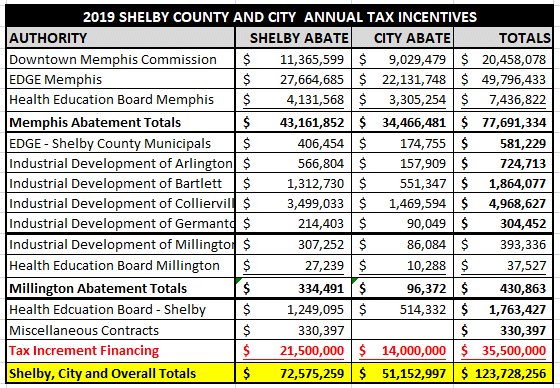Nobody in local government knows the amount of total annual tax incentives occurring across Shelby County. And the information is certainly not published. Therefore, there is no measurement.
This blog will share some analytical facts about incentives occurring in Memphis which also includes Shelby County tax abatements, as well new information on TIFs while revealing some unknowns. These unknowns leave taxpayers in the dark resulting in an inability to evaluate the return on investment for tax incentives.
The data was compiled using the 2018 Shelby County Trustee Report and through a series of public information requests.
City of Memphis
First lets draw some analytical conclusions from the table above. The table was derived from the 2019 Shelby County Trustee report that involves abatements occurring exclusively in the City of Memphis. You may need to click to enlarge the above table entitled “Memphis Public-Private Property Tax Conversion Scorecard”.
The scorecard communicates the impact of excessive tax abatements and deficient total wage growth on property taxes while calculating the needed property tax to make up the deficit for deficient public-private economic development results. Here are some conclusions from the scorecard for Memphis:
Excess tax abatements, when benchmarked against other cities, result in 2.7% Shelby County and 6.5% City of Memphis deficient tax revenues.
Excessive tax abatements translate into a Shelby County property tax increase from $4.05 to $4.16 and City of Memphis increase from $3.19 to $3.43 for a combined City/County increase from excessive abatements to $7.59
Deficient total wage growth results in a 3.8% County and 7.5% City property tax increase for a total combined tax increase when added to $7.59 of $7.99 Memphis property owners.
This revenue need comes from excessive County abatements of $21.5M and City of $17.3M and deficient County revenue from deficient total wage growth of $30M and the City of $20M for total deficient City/County revenue of $89M as of the end of 2019. Total deficient County revenue from this analysis is $51.5M and City of Memphis $37M
The City of Memphis PILOT report was discarded due to the fact that the City of Memphis could not answer questions regarding inaccurate PILOT information when compared to the County Trustee Report and involving large locally known PILOTs. This inaccurate information of the City report has the effect of greatly lowering the City taxes abated as shown on the 2019 City of Memphis PILOT report.
County Overall and TIFs
Through an examination of public documentation and public information request, it is estimated that there are $123M in annual recurring tax incentives per year occurring across all of Shelby County. This $123M figure was updated from a previous published blog of $90M. The update came as a result of new information obtained by public information request from Shelby County that informed a $21.5M estimate for tax increment financing (TIF) incentives that was not part of the previous $90M total.
In the public information response, Shelby County Government could only provide the annual TIF revenue figure of $6.5M. TIFs range from 65% to 100% of property tax revenue growth being restricted for use in the TIF district with local government recognizing 0% to 35% as revenue from increased property values.
To derive the County TIF incentive figure, 70% was assumed as the total TIF incentive. Once the total County TIF incentive figure of $21.5M is derived from the given $6.5M in County TIF revenue, 65% of the $21.5M was assumed for municipal TIF incentives for a total of $14M. The addition of these figures resulted in $72.5M in total Shelby County tax incentives and $51M in municipal incentives for a total of $123M in tax incentives occurring annually across all of Shelby County when adding the TIF totals to the abatement total.
Conclusion
A large portion of future tax increases or services cuts, in a Memphis community in need, comes from excessive incentives for the small few and deficient total wage growth. In exchange for tax incentives, competitive total wage growth and increased commercial property values are the carrots offered to local taxpayers. This resulting equation of excessive tax incentives and deficient total wage growth will never work for taxpayers and the business community as a whole in a Memphis community in need.


